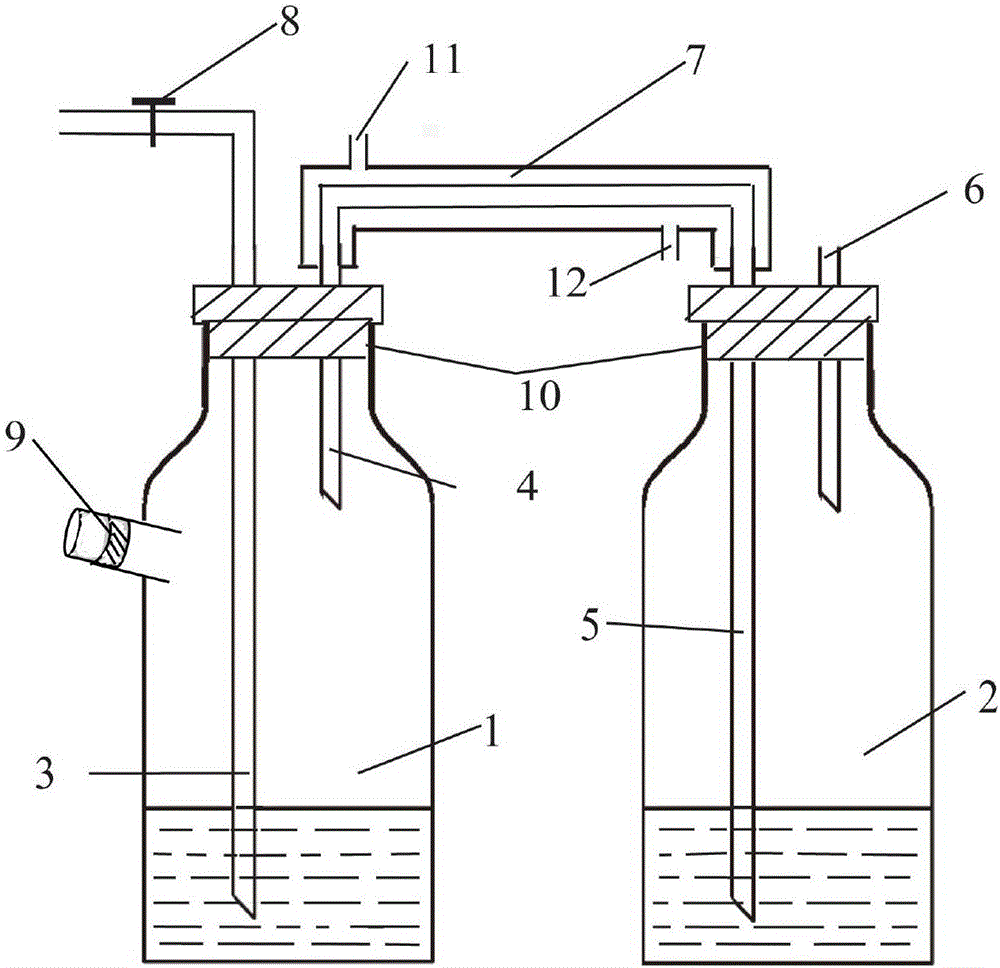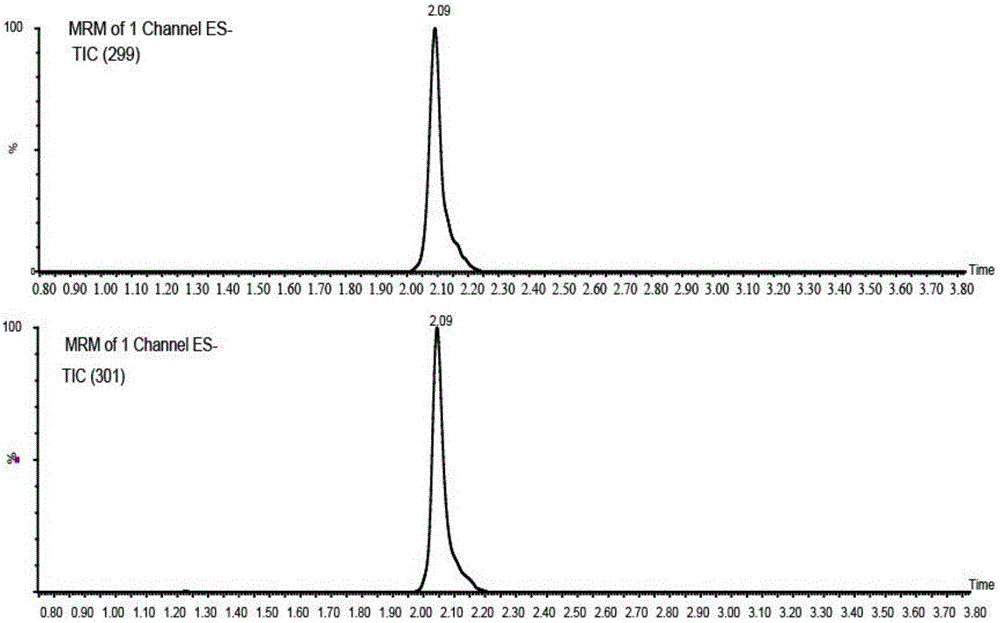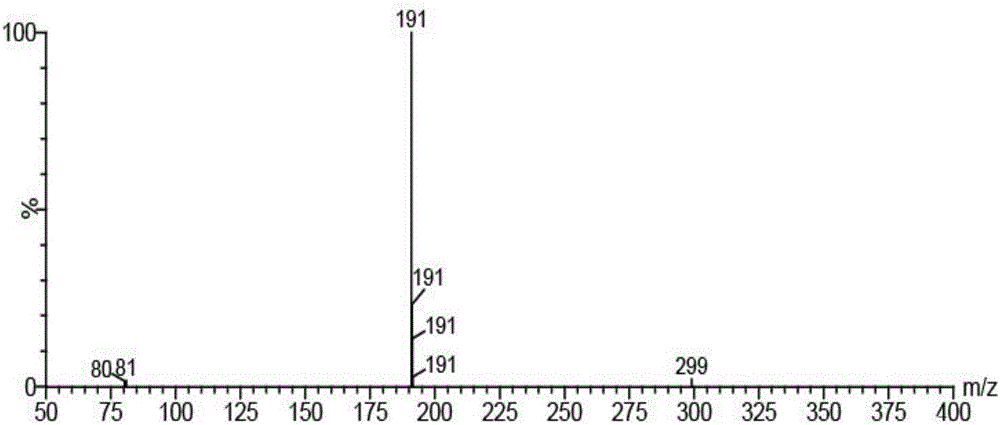Method for detecting free and bound trace cyanide
A cyanide, free state technology, applied in the field of analysis and detection, can solve the problems of low detection sensitivity, easy interference, high detection limit, complicated operation, etc., and achieve the effect of reducing detection inaccuracy, easy operation, and simplified operation.
- Summary
- Abstract
- Description
- Claims
- Application Information
AI Technical Summary
Problems solved by technology
Method used
Image
Examples
Embodiment 1
[0040] Embodiment 1: the mensuration of free state and combined state cyanide in yellow rice wine
[0041] (1) Pretreatment and derivatization of rice wine samples:
[0042] a. Sample pretreatment and derivatization for the determination of free cyanide: Add 2 mL of rice wine sample to the sample reaction bottle of the pretreatment and derivatization device, add 1 mL of lactic acid, and convert cyanide into hydrocyanic acid. Under the condition of blowing nitrogen, transfer the hydrocyanic acid to the derivatization receiving bottle. Pre-accurately add 2mL of derivatizer and 10μL of internal standard with a concentration of 1mg / L in the derivatization receiving bottle 13 C 15 N-cyanide standard solution. The derivatization reaction between the derivatizing agent and hydrocyanic acid takes place at room temperature for 20 minutes. The derivatized product was obtained, and the content of free cyanide was detected by sample injection.
[0043] b. Sample pretreatment and deri...
Embodiment 2
[0050] Embodiment 2: the mensuration of total cyanide in water
[0051] (1) Sample pretreatment and derivatization:
[0052] Sample pretreatment and derivatization for the determination of total cyanide: add 2 mL of water sample to the sample reaction bottle of the pretreatment and derivatization device, add about 10 mL of distilled water, quickly add 1 g of tartaric acid and 2 mL of 100 g / L zinc acetate, and conduct boiling water The bath is heated and distilled, and the distillate is received by a derivation receiving bottle. Pre-accurately add 2mL of derivatizer and 100μL of internal standard with a concentration of 5mg / L in the derivatization receiving bottle 13 C 15 N-cyanide standard solution. Distillation was stopped when the distillate was close to 10 mL. The distillate was fixed to volume, and the sample was injected to detect the total cyanide content.
[0053] (2) Using Thermo Fisher TSQ Quantum Ultra EMR Triple Quadrupole Liquid Mass Spectrometry to Cyanide De...
Embodiment 3
[0058] Embodiment 3: Evaluation of cyanide detection method
[0059] (1) Repeatability - precision test
[0060] Six standard solutions with a concentration of 10 μg / L were tested respectively, and the final results are shown in Table 1. The test results show that this method has good reproducibility.
[0061] Table 1 Precision
[0062]
[0063] (2) Recovery rate - accuracy test
[0064] Take 6 samples of yellow rice wine with a free cyanide concentration of 4.71 μg / L, add standard substances with a concentration of 2.5 and 10 μg / L accurately, and measure according to the above steps. The recoveries were 93.8% and 106%, respectively. See Table 2 for details.
[0065] Table 2. Recovery rates
[0066]
[0067] (3) Limit of detection and limit of quantitation
[0068] When the injection volume is 2 μL and S / N=3, the LOD of cyanide determination is 0.01 μg / L; when the injection volume is 2 μL and S / N=10, the LOQ is 0.05 μg / L.
PUM
 Login to View More
Login to View More Abstract
Description
Claims
Application Information
 Login to View More
Login to View More - R&D
- Intellectual Property
- Life Sciences
- Materials
- Tech Scout
- Unparalleled Data Quality
- Higher Quality Content
- 60% Fewer Hallucinations
Browse by: Latest US Patents, China's latest patents, Technical Efficacy Thesaurus, Application Domain, Technology Topic, Popular Technical Reports.
© 2025 PatSnap. All rights reserved.Legal|Privacy policy|Modern Slavery Act Transparency Statement|Sitemap|About US| Contact US: help@patsnap.com



